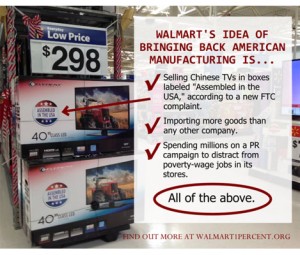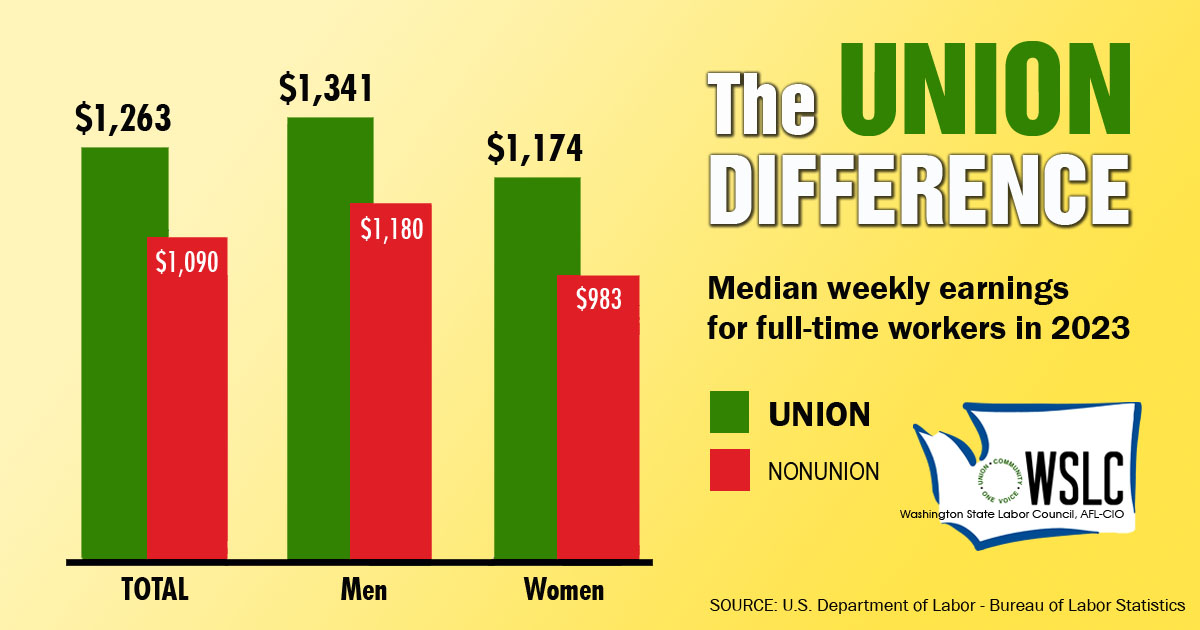NATIONAL
How Walmart destroyed U.S. manufacturing
The following article by Molly McGrath and Brad Markell is crossposted from AFL-CIO Now:
 (Nov. 17, 2014) — Walmart has spent millions of dollars in the past two years on public relations promotions, advertising and conferences, trying to convince us that it, well, cares about America. From championing hiring veterans (which is noble, yes, but veterans deserve better than poverty wage jobs, and Walmart receives a substantial tax break for hiring them) to promoting “U.S. manufacturing,” the company has tried to evade the common sense of real, hardworking Americans by helping them forget Walmart was responsible for our manufacturing sector’s demise in the first place.
(Nov. 17, 2014) — Walmart has spent millions of dollars in the past two years on public relations promotions, advertising and conferences, trying to convince us that it, well, cares about America. From championing hiring veterans (which is noble, yes, but veterans deserve better than poverty wage jobs, and Walmart receives a substantial tax break for hiring them) to promoting “U.S. manufacturing,” the company has tried to evade the common sense of real, hardworking Americans by helping them forget Walmart was responsible for our manufacturing sector’s demise in the first place.
That’s why the Alliance for American Manufacturing’s petition to the Federal Trade Commission (FTC), which has exposed the false claims by Walmart’s supplier Element Electronics, that its TVs are “Assembled in America” is so important. There isn’t enough work being performed on Element’s TVs once they arrive in the United States from China in their boxes (already covered in American flags), to meet the standard prescribed by the FTC for “Assembled in America.” To meet it, the FTC says, a products’ “principal assembly takes place in the U.S. and the assembly is substantial.”
On the surface, with the help of slick public relations firms, Walmart’s U.S. Manufacturing Initiative seems patriotic and good for the country, but it does not live up to the hype. Here are five reasons why:
1. Walmart drove these jobs away in the first place.
Walmart’s commercials touting Element’s “Assembled in the USA” TVs show America’s workers in Winnsboro, S.C., who are grateful for having jobs, and job creation should be applauded. But don’t forget, Walmart played the central, if not the defining, role in the off-shoring of high-quality U.S. manufacturing jobs over the past 25 years. Companies that used to manufacture products in the United States, from Levi’s jeans to Master Lock, were pressured to shut their U.S. factories and move manufacturing abroad to meet Walmart’s demand for low prices. In fact, Element Electronics is now housed in a Perry Ellis plant that closed in 2008.
2. Walmart is the nation’s largest importer.
Walmart holds the champion title as the nation’s largest importer. This is no small feat. According to trade data published by the Journal of Commerce, Walmart continues to be the largest importer of goods to the United States in 2013. And company imports have increased by 2.5 times since 2002. Meanwhile, many of Walmart’s chosen U.S. suppliers, like Element Electronics and Kent International, will continue to import the majority of their televisions and bicycles, respectively, sold in the United States; and for their “American-made or assembled” products, they will import the majority, if not all, of the products’ components.
To really rebuild U.S. manufacturing, Americans need actual manufacturing—not just assembly—jobs.
3. Wages are just too low.
Wages are at the crux of Walmart’s attempt to fool consumers. Wages at many of these suppliers in Walmart’s U.S. Manufacturing Initiative are considerably lower than average. This is because Walmart requires extremely low labor costs for any Walmart U.S. manufacturing deal. At Element Electronics, a worker averages about $12.50 per hour. According to the federal Bureau of Labor Statistics, the average median wage for a manufacturing worker in October 2014 is $19.64. Walmart put American workers’ jobs in harm’s way by driving off-shoring and job loss in its hunt for ever lower prices. In bringing them back, they should be held to a higher standard.
4. Taxpayers are on the hook for these bad jobs.
To top it all off, Walmart and its partner U.S. suppliers are taking full advantage of the American taxpayer by getting big state and local incentive packages to subsidize the creation of the small amount of jobs Walmart and its partners are creating. Element Electronics takes the cake. The factory in Winnsboro was opened with a large incentive deal from the state and county—including corporate income tax credits, job training and property tax rebates. Combined, according to a cost benefit analysis that was part of the county’s impact analysis, the package would cost an estimated $14.8 million to the public over 15 years. The county also purchased the building and has leased it to Element; in three years, it can simply transfer the title.
Walmart should be responsible for a greater part of its own U.S. Manufacturing Initiative, not U.S. taxpayers.
5. We love “Made in America,” and Walmart knows you will pay more for it.
Walmart exists to sell more stuff and at a higher profit margin. It’s a retailer. But Americans will pay more to keep their fellow citizens employed, according to a widely cited Boston Consulting Group survey, more than 80% of Americans are willing to pay more for American-made or assembled products, almost all of whom say because they want to keep jobs in the United States. Walmart, doing what it does best, follows with the red, white and blue-splattered packaging. Stephen Quinn, Walmart’s chief marketing officer said at Walmart’s Manufacturing Summit in August, “We know that customers prefer products made in the USA, and so it follows that if it’s going to change customers’ minds, they really have to know about it. And that starts with the silent salesmen: your packaging. It’s critically important that your packaging clearly communicate that your product supports American jobs.”
And that brings us back to this week’s FTC petition accusing Walmart supplier Element Electronics of false advertising. As Walmart’s Stephen Quinn was telling the crowd about the importance of patriotic packaging, pictures of Element’s red, white and blue, “Assembled in the USA”-emblazoned boxes flashed on the screen behind him. It seems Walmart will do anything to avoid actually creating good, middle-class jobs in its stores or with its suppliers.
For more information, Walmart1Percent.org.





